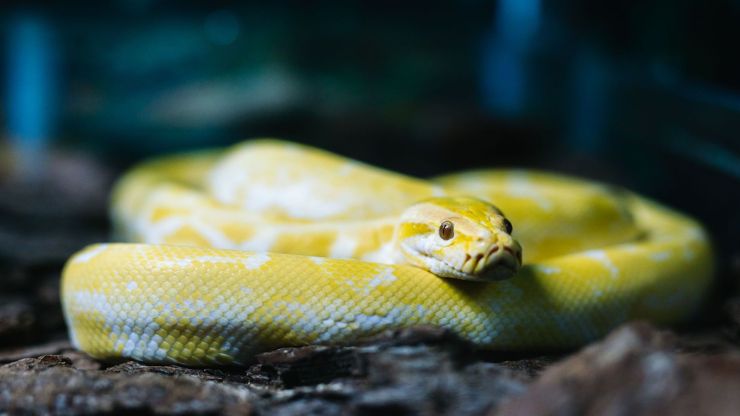Most Popular Snake Species in the US – In the United States, the fascination with reptiles, particularly snakes, has led to a thriving pet trade centered around these enigmatic creatures. Among the plethora of reptilian options, snakes stand out as one of the most sought-after choices for pet enthusiasts. Their allure lies not only in their exotic appearance but also in their low maintenance requirements and intriguing behaviors. This guide aims to explore the most popular snake species in the US, shedding light on their distinctive characteristics, care needs, and reasons for their widespread appeal. From the docile and easily handled Ball Python to the vibrant and active Corn Snake, each species offers its own unique charm and challenges. Understanding the intricacies of these fascinating reptiles not only enriches the experience of snake ownership but also fosters a deeper appreciation for the diverse wildlife that shares our planet. Whether you’re a seasoned reptile enthusiast or a curious beginner, embarking on the journey of snake ownership promises to be a rewarding and educational adventure.
Table of Contents
ToggleMost Popular Snake Species in the US
Eastern Garter Snake (Thamnophis sirtalis):
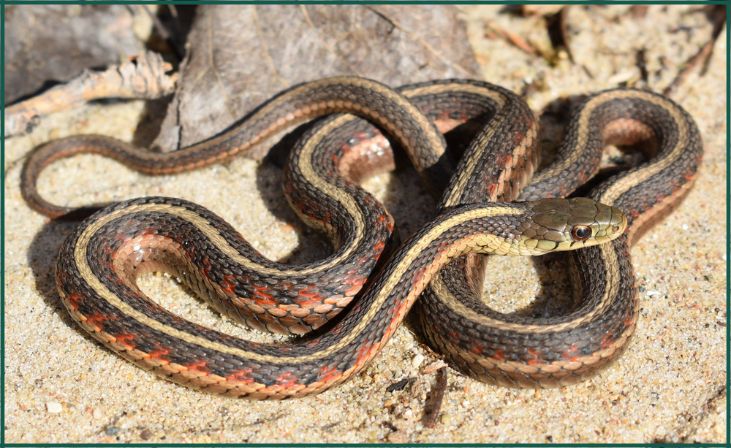
The Eastern Garter Snake, Thamnophis sirtalis, is one of the most widespread and commonly encountered snake species in the eastern and central United States. It typically has a black, brown, or greenish body with three longitudinal stripes running down its back, though coloration can vary widely. Garter snakes are relatively small, typically ranging from 18 to 26 inches in length, though some individuals may grow larger. They are non-venomous and pose no threat to humans. These snakes are highly adaptable and can be found in a variety of habitats, including grasslands, forests, wetlands, and suburban areas. They primarily feed on small prey such as insects, earthworms, frogs, and small rodents. Garter snakes are often found near water sources, as they are good swimmers and may hunt for aquatic prey. They play an important role in controlling pest populations and are generally beneficial to ecosystems.
Also, Read – The 8 Best Animals To Keep As Pets in 2024
Western Diamondback Rattlesnake (Crotalus atrox):
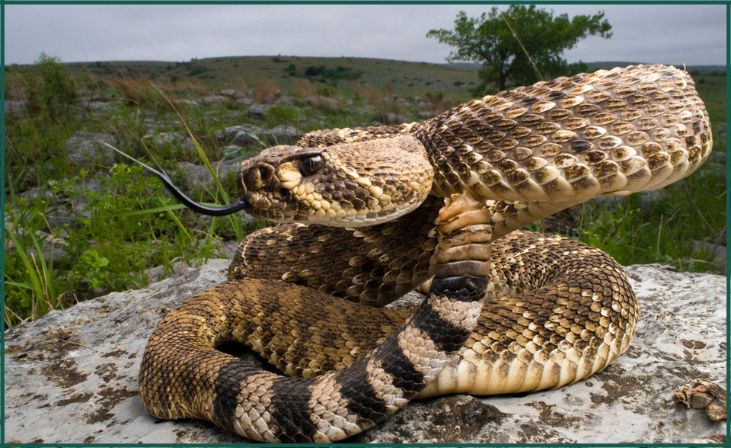
The Western Diamondback Rattlesnake, Crotalus atrox, is a venomous pit viper species found primarily in the southwestern United States and northern Mexico. It is one of the largest rattlesnake species, with adults typically reaching lengths of 3 to 5 feet, although some individuals may grow larger. Western Diamondbacks are characterized by their distinctive diamond-shaped pattern along their back, which is outlined in lighter scales. They also possess a rattle at the end of their tail, which they use as a warning signal when threatened. These snakes are ambush predators, often lying in wait for prey such as rodents, birds, and lizards. Their venom is potent and can cause serious injury or death to humans if bitten. However, they are generally shy and will usually try to avoid confrontation with humans. Western Diamondback Rattlesnakes are an important part of their ecosystem, helping to control rodent populations and serving as prey for larger predators.
Eastern Diamondback Rattlesnake (Crotalus adamanteus):

The Eastern Diamondback Rattlesnake, Crotalus adamanteus, is the largest venomous snake species in North America, native to the southeastern United States. It is known for its impressive size, with adults commonly reaching lengths of 5 to 7 feet, although some individuals have been recorded at over 8 feet long. Eastern Diamondbacks are easily recognized by their distinctive diamond-shaped pattern along their back, which is outlined in lighter scales. Like other rattlesnake species, they also possess a rattle at the end of their tail, which they use as a warning signal when threatened. These snakes are ambush predators, primarily feeding on small mammals such as rabbits, squirrels, and rats. Their venom is highly potent and can cause serious injury or death to humans if bitten. However, Eastern Diamondback Rattlesnakes are generally shy and will usually try to avoid confrontation with humans. They play an important role in their ecosystem by controlling rodent populations and serving as prey for larger predators.
Timber Rattlesnake (Crotalus horridus):

The Timber Rattlesnake, Crotalus horridus, is a venomous pit viper species found primarily in the eastern United States, from Minnesota to Texas and eastward to the Atlantic coast. It is known for its distinctive rattle, which it uses as a warning signal when threatened. Timber Rattlesnakes are relatively large, with adults typically reaching lengths of 3 to 4 feet, although some individuals may grow larger. They are characterized by their brown or grayish body coloration, which is often patterned with dark crossbands or blotches. These snakes are ambush predators, often lying in wait for prey such as rodents, birds, and lizards. Their venom is potent and can cause serious injury or death to humans if bitten, although fatalities are rare with prompt medical treatment. Timber Rattlesnakes are generally shy and will usually try to avoid confrontation with humans. They play an important role in their ecosystem by controlling rodent populations and serving as prey for larger predators.
Don't just scroll, subscribe!
BuzzTrail's unique web-stories are the cure for boredom you've been waiting for.
Also, Read – Top 8 Ideal Pets For Those Who Love Reptiles
Cottonmouth (Agkistrodon piscivorus):
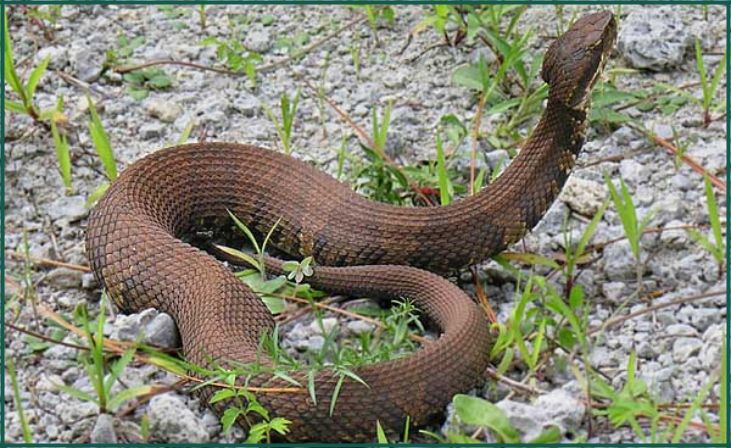
The Cottonmouth, Agkistrodon piscivorus, also known as the water moccasin, is a venomous pit viper species found primarily in the southeastern United States. It is named for its white mouth, which it displays as a warning signal when threatened, although this behavior is not unique to cottonmouths. Cottonmouths are semi-aquatic snakes, commonly found in and around bodies of water such as swamps, marshes, streams, and ponds. They are relatively large, with adults typically reaching lengths of 2 to 4 feet, although some individuals may grow larger. Cottonmouths are characterized by their dark coloration, which varies from olive-brown to black, and their keeled scales. These snakes are opportunistic feeders, consuming a variety of prey including fish, frogs, small mammals, and other snakes. Their venom is potent and can cause serious injury or death to humans if bitten, although fatalities are rare with prompt medical treatment. Cottonmouths are generally shy and will usually try to avoid confrontation with humans. They play an important role in their ecosystem by controlling prey populations and serving as prey for larger predators.
Eastern Coral Snake (Micrurus fulvius):
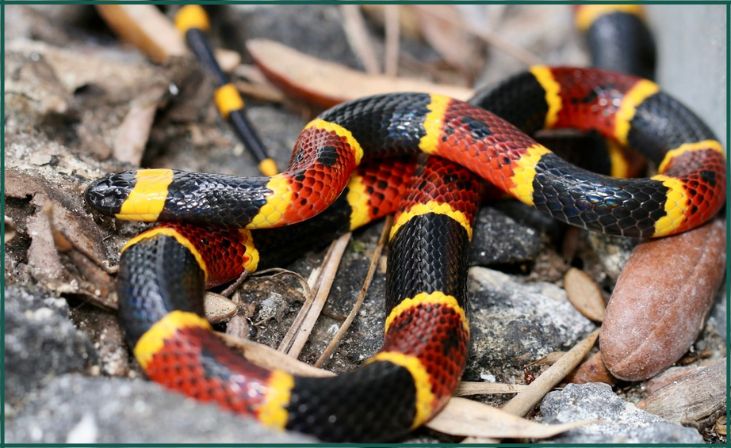
The Eastern Coral Snake, Micrurus fulvius, is a highly venomous snake species found primarily in the southeastern United States, from North Carolina to Florida and westward to Texas. It is known for its distinctive coloration, which consists of alternating bands of red, yellow, and black. The red and yellow bands are usually touching, while the black bands are separated by narrower white or yellow bands. This color pattern serves as a warning signal to potential predators, as coral snakes possess potent neurotoxic venom. Eastern Coral Snakes are relatively small, with adults typically reaching lengths of 2 to 3 feet. They are secretive snakes, spending much of their time hidden underground or beneath leaf litter. They primarily feed on small reptiles and amphibians, including lizards, frogs, and other snakes. Coral snakes are not aggressive and will usually try to avoid confrontation with humans. Bites are rare, as these snakes are reclusive and not often encountered. However, their venom can cause respiratory failure and paralysis if not treated promptly.
Corn Snake (Pantherophis guttatus):
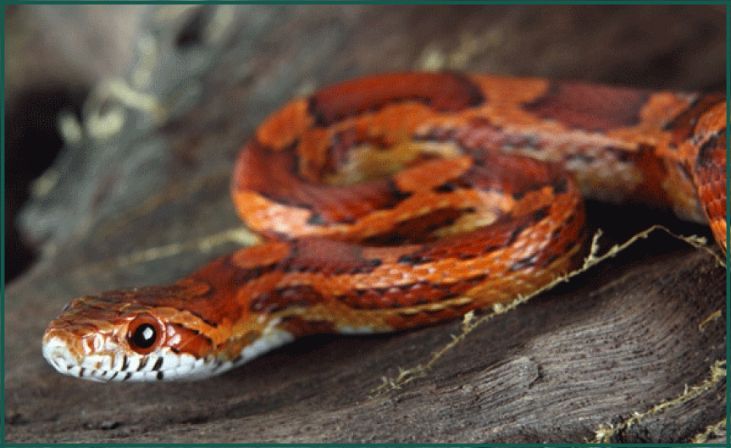
The Corn Snake, Pantherophis guttatus, is a non-venomous constrictor species found throughout the southeastern and central United States, from New Jersey to the Florida Keys and westward to Louisiana and Kentucky. It is one of the most popular pet snake species due to its docile nature, attractive coloration, and ease of care. Corn Snakes are relatively small, with adults typically reaching lengths of 3 to 5 feet. They are highly variable in color and pattern, with individuals displaying a wide range of morphs including albino, hypo, anerythristic, and more. Wild-type Corn Snakes typically have a reddish-brown or orange ground color with large black-edged red blotches down the back and smaller black spots along the sides. These snakes are primarily nocturnal, hunting for prey such as rodents,
Conclusion
In conclusion, the diverse array of popular snake species in the US offers enthusiasts a fascinating glimpse into the world of reptilian companionship. From the gentle Ball Python to the active Corn Snake and the striking California Kingsnake, each species brings its own allure and challenges. Understanding their unique needs and behaviors enriches the experience of snake ownership and fosters a deeper appreciation for these captivating creatures. Whether you’re a seasoned reptile enthusiast or a curious beginner, the journey of snake ownership promises both rewards and opportunities for learning, providing a fulfilling connection to the natural world around us.
FAQs
What are the most popular snake species kept as pets in the US?
What are the most popular snake species kept as pets in the US?
The most popular snake species among pet owners in the US include Ball Pythons, Corn Snakes, King Snakes, California Kingsnakes, and Garter Snakes.
Are these snake species suitable for beginners?
Are these snake species suitable for beginners?
Yes, many of these species are considered suitable for beginners due to their docile nature, ease of care, and adaptability to captivity. Corn Snakes and Ball Pythons, in particular, are often recommended for novice snake keepers.

